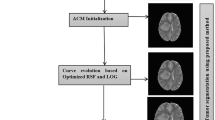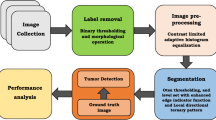Abstract
Purpose
The intensity profile of an image in the vicinity of a tissue’s boundary is modeled by a step/ramp function. However, this assumption does not hold in cases of low-contrast images, heterogeneous tissue textures, and where partial volume effect exists. We propose a hybrid algorithm for segmentation of CT/MR tumors in low-contrast, noisy images having heterogeneous/homogeneous or hyper-/hypo-intense abnormalities. We also model a smoothed noisy intensity profile by a sigmoid function and employ it to find the true location of boundary more accurately.
Methods
A novel combination of the SVM, watershed, and scattered data approximation algorithms is employed to initially segment a tumor. Small and large abnormalities are treated distinctly. Next, the proposed sigmoid edge model is fitted to the normal profile of the border. The estimated parameters of the model are then utilized to find true boundary of a tissue.
Results
We extensively evaluated our method using synthetic images (contaminated with varying levels of noise) and clinical CT/MR data. Clinical images included 57 CT/MR volumes consisting of small/large tumors, very low-/high-contrast images, liver/brain tumors, and hyper-/hypo-intense abnormalities. We achieved a Dice measure of \(0.83\,(\pm 0.07)\) and average symmetric surface distance of \(2.56\,(\pm 6.31)\) mm. Regarding IBSR dataset, we fulfilled Jaccard index of \(0.85\,(\pm 0.07)\). The average run-time of our code was \(154\,(\pm 71)\) s.
Conclusion
Individual treatment of small and large tumors and boundary correction using the proposed sigmoid edge model can be used to develop a robust tumor segmentation algorithm which deals with any types of tumors.















Similar content being viewed by others
Explore related subjects
Discover the latest articles and news from researchers in related subjects, suggested using machine learning.References
3D Slicer. http://www.Slicer.org/. Accessed 20 June 2015
Abdel-massieh NH, Hadhoud MM, Amin KM (2010) Automatic liver tumor segmentation from ct scans with knowledge-based constraints. In: 2010 5th Cairo International Biomedical Engineering Conference (CIBEC), pp 215–218
American Cancer Society (2011) Global Cancer Facts and Figures, 2nd edn [Online]. http://www.cancer.org/acs/groups/content/@epidemiologysurveilance/documents/document/acspc-027766.pdf
Behnaz AS, Snider J, Chibuzor E, Esposito G, Wilson E, Yaniv Z et al (2010) Quantitative CT for volumetric analysis of medical images: initial results for liver tumors. In: SPIE Medical Imaging. International Society for Optics and Photonics, pp 76233U–76238U
Boykov Y, Kolmogorov V (2004) An experimental comparison of min-cut/max-flow algorithms for energy minimization in vision. Pattern Analysis and Machine Intelligence, IEEE Transactions on 26(9):1124–1137
BrainWeb: simulated brain database. http://www.bic.mni.mcgill.ca/brainweb/. Accessed 20 Mar 2015
Caselles V, Kimmel R, Sapiro G (1997) Geodesic active contours. Int J Comput Vis 22(1):61–79
Choudhary A, Moretto N, Ferrarese FP, Zamboni GA (2008) An entropy based multi-thresholding method for semi-automatic segmentation of liver tumors. In: MICCAI Workshop 41(43):43–49
Claridge E, Orun A (2002) Modelling of edge profiles in pigmented skin lesions. In: Proceedings of medical image understanding and analysis, pp 53–56
Cristianini N, Shawe-Taylor J (2000) An introduction to support vector machines and other kernel-based learning methods. Cambridge University Press, Cambridge
FMRIB software library. http://www.fmrib.ox.ac.uk/fsl/. Accessed 7 June 2015
Foruzan AH, Chen YW, Zoroofi RA, Furukawa A, Hori M, Tomiyama N (2013) Segmentation of liver in low-contrast images using K-means clustering and geodesic active contour algorithms. IEICE Trans Inform Syst 96(4):798–807
Freiman M, Cooper O, Lischinski D, Joskowicz L (2011) Liver tumors segmentation from CTA images using voxels classification and affinity constraint propagation. Int J Comput Assist Radiol Surg 6(2):247–255
Gonzalez RC (2009) Digital image processing. Pearson Education India, Delhi
Goryawala M (2012) A novel 3-D segmentation algorithm for anatomic liver and tumor volume calculations for liver cancer treatment planning. Florida International University
Grau V, Mewes AUJ, Alcaniz M, Kikinis R, Warfield SK (2004) Improved watershed transform for medical image segmentation using prior information. IEEE Trans Med Imaging 23(4):447–458
Gu Y, Kumar V, Hall LO, Goldgof DB, Li CY, Korn R et al (2013) Automated delineation of lung tumors from CT images using a single click ensemble segmentation approach. Pattern Recognit 46(3):692–702
Han XH, Chen YW, Xu G (2014) Bayesian-based saliency model for liver tumor enhancement. In: Frontiers in Artificial Intelligence and Applications, vol 262: Smart Digital Futures
Heckel F, Meine H, Moltz JH, Kuhnigk JM, Heverhagen JT, Kiessling A et al (2014) Segmentation-based partial volume correction for volume estimation of solid lesions in CT. IEEE Trans Med Imaging 33(2):462–480
Hopper KD, Kasales CJ, Eggli KD, TenHave TR, Belman NM, Potok PS et al (1996) The impact of 2D versus 3D quantitation of tumor bulk determination on current methods of assessing response to treatment. J Comput Assist Tomogr 20(6):930–937
Insight toolkit. http://www.ITK.org/. Accessed 20 June 2015
Kwan RS, Evans AC, Pike GB (1999) MRI simulation-based evaluation of image-processing and classification methods. IEEE Trans Med Imaging 18(11):1085–1097
Li BN, Chui CK, Chang S, Ong SH (2011) Integrating spatial fuzzy clustering with level set methods for automated medical image segmentation. Comput Biol Med 41(1):1–10
Li C, Wang X, Eberl S, Fulham M, Yin Y, Chen J, Feng DD (2013) A likelihood and local constraint level set model for liver tumor segmentation from CT volumes. IEEE Trans Biomed Eng 60(10):2967–2977
Linguraru MG, Richbourg WJ, Liu J, Watt JM, Pamulapati V, Wang S, Summers RM (2012) Tumor burden analysis on computed tomography by automated liver and tumor segmentation. IEEE Trans Med Imaging 31(10):1965–1976
Masuda Y, Tateyama T, Xiong W, Zhou J, Wakamiya M, Kanasaki S et al (2011). Liver tumor detection in CT images by adaptive contrast enhancement and the EM/MPM algorithm. In: 2011 18th IEEE International Conference on Image Processing (ICIP), pp 1421–1424
Mertler CA, Vannatta RA (2002) Advanced and multivariate statistical methods. Pyrczak, Los Angeles
Nugroho HA, Ihtatho D, Nugroho H (2008) Contrast enhancement for liver tumor identification. Midas J. http://www.midasjournal.org/browse/publication/596
Perona P, Malik J (1990) Scale-space and edge detection using anisotropic diffusion. IEEE Trans Pattern Anal Mach Intell 12(7):629–639
Prasad SR, Jhaveri KS, Saini S, Hahn PF, Halpern EF, Sumner JE (2002) CT tumor measurement for therapeutic response assessment: comparison of unidimensional, bidimensional, and volumetric techniques-initial observations 1. Radiology 225(2):416–419
Punys V, Maknickas R (2010) Cell edge detection in JPEG2000 wavelet domain-analysis on sigmoid function edge model. Stud Health Technol Inform 169:470–474
Qi Y, Xiong W, Leow WK, Tian Q, Zhou J, Liu J et al (2008) Semi-automatic segmentation of liver tumors from CT scans using Bayesian rule-based 3D region growing. Midas J. http://www.midasjournal.org/browse/publication/591
Rencher AC (2003) Methods of multivariate analysis, vol 492. Wiley, New York
Slotani M (1964) Tolerance regions for a multivariate normal population. Ann Inst Stat Math 16(1):135–153
Smeets D, Loeckx D, Stijnen B, De Dobbelaer B, Vandermeulen D, Suetens P (2010) Semi-automatic level set segmentation of liver tumors combining a spiral-scanning technique with supervised fuzzy pixel classification. Med Image Anal 14(1):13–20
Soler L, Hostettler A, Agnus V, Charnoz A, Fasquel JB, Moreau J et al (2010) 3D image reconstruction for comparison of algorithm database: a patient-specific anatomical and medical image database
Stawiaski J, Decenciere E, Bidault F (2008) Interactive liver tumor segmentation using graph-cuts and watershed. In: Workshop on 3D segmentation in the clinic: a grand challenge II, Liver Tumor Segmentation Challenge. MICCAI, New York, USA
The internet brain segmentation repository. http://www.nitrc.org/projects/ibsr/. Accessed 20 Mar 2015
Timan AF (1963) Theory of approximation of functions of a real variable, vol 34. Courier Dover Publications, New York
Van Ginneken B, Heimann T, Styner M (2007) 3D segmentation in the clinic: a grand challenge. In: 3D segmentation in the clinic: a grand challenge, pp 7–15
Zhou JY, Wong DW, Ding F, Venkatesh SK, Tian Q, Qi YY et al (2010) Liver tumour segmentation using contrast-enhanced multi-detector CT data: performance benchmarking of three semiautomated methods. Eur Radiol 20(7):1738–1748
Acknowledgments
The authors would like to thank Prof. Yoshinobu Sato and Prof. Masatoshi Hori, Osaka University, Osaka, Japan, for the use of their images in this study. The authors would like to thank Mr. Ehsan Reza-Zadeh too.
Conflict of interest
Amir H. Foruzan and Yen-Wei Chen declare that they have no conflict of interest.
Author information
Authors and Affiliations
Corresponding author
Appendix
Appendix
We evaluate Eq. (9) for regions R1–R3 (Fig. 6b). It can be assumed that variance of the Gaussian filter is smaller than important structures present in the image, i.e. \(\sigma {<}T\). Therefore, the lower and upper limits of the integral in Eq. (9) may be changed into \(\left[ {t-4\sigma ,t+4\sigma } \right] \) since the surface under a normal distribution has \(<\)0.01 % outside this range. To evaluate Eq. (9) for R1, it is rewritten as Eq. (17).
Regarding region R2, Eq. (9) at \(t=T\) is calculated by Eqs. (18) and (19).
Rights and permissions
About this article
Cite this article
Foruzan, A.H., Chen, YW. Improved segmentation of low-contrast lesions using sigmoid edge model. Int J CARS 11, 1267–1283 (2016). https://doi.org/10.1007/s11548-015-1323-x
Received:
Accepted:
Published:
Issue Date:
DOI: https://doi.org/10.1007/s11548-015-1323-x




